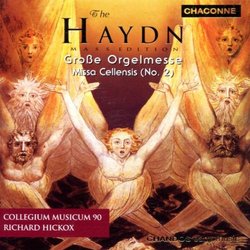Haydn on the Road to Choral Music Greatness
M. C. Passarella | Lawrenceville, GA | 08/10/2005
(5 out of 5 stars)
"This is the first volume I've heard in toto of the wonderfully useful Haydn mass series by Richard Hickox and Collegium Musicum 90. And this is a good place to start, especially for those, like me, who are much more familiar with Haydn's great final masses than with earlier ones. The reason is this CD gives a wonderful snapshot of the creative progress made in the time span covered by these two masses, the Grosse Orgelmesse (1768-69) and the Missa Cellensis No. 2 (1782). It is a little over ten years, but it is a decade in which Haydn grew into a composer of truly international stature. After all, just three years later, in 1785-86, Haydn would thrill France with his six Paris Symphonies. In Missa Cellensis No. 2, the polished high-classical idiom of the Paris Symphonies is already in place, so this work is much more reminiscent of the great masses of the 1790s than of the masses of the 1760s. Whereas the archaeological record is complete with the symphonies and string quartets, and we can trace Haydn's remarkable creative development through the 1770s, it's as though there is a missing link in the case of the masses: it's as though we leaped from Symphony No. 48 "Maria Theresa" (1769) to Symphony No. 85 "La Reine" (1785) without hearing the progress Haydn had made in the intervening 35 or so symphonies. Fascinating.
This is not to say that the Grosse Orgelmesse is not an accomplished and endearing work in its own right. But it's probably safe to say that if Haydn had written no masses after the Kleine Orgelmesse of 1778, he would not be known as an important composer of church music. The most prominent feature of these two organ masses, as the name implies, is the part for obligato organ. In the present recording, Ian Watson plays the organ with refinement, and the vocal soloists turn in equally polished performances of the undemanding solo music. Collegium Musicum 90 plays with such tonal beauty that you forget it is an authentic-instruments orchestra (listen to those horns in the Sanctus). The chorus is equally fine.
Still, the really good stuff here is the striking Missa Cellensis in Haydn's best C-major celebatory vein, with prominent parts for trumpets and drums. Maybe the musical content isn't as memorable as in the late masses--there's a bit of meandering and repetitiousness in the Gratias agimus tibi, and the final Dona nobis is clipped, without the quality of grand peroration we get in the great works--but on the other hand, the opening Kyrie is a well-wrought sonata movement in the manner of the late masses, and the thrilling Gloria sounds like it might be a study for the Gloria of the great Paukenmesse of 1796. So the Missa Cellensis No. 2 is a Haydn mass to know and cherish, especially in as fine a performance and recording as we have here. The spirit of celebration is perfectly captured by Hickox's forces, and again the singing and playing are beyond cavil. A beautifully detailed yet airy recording adds more luster to the production. I'm happy!
"


 Track Listings (20) - Disc #1
Track Listings (20) - Disc #1